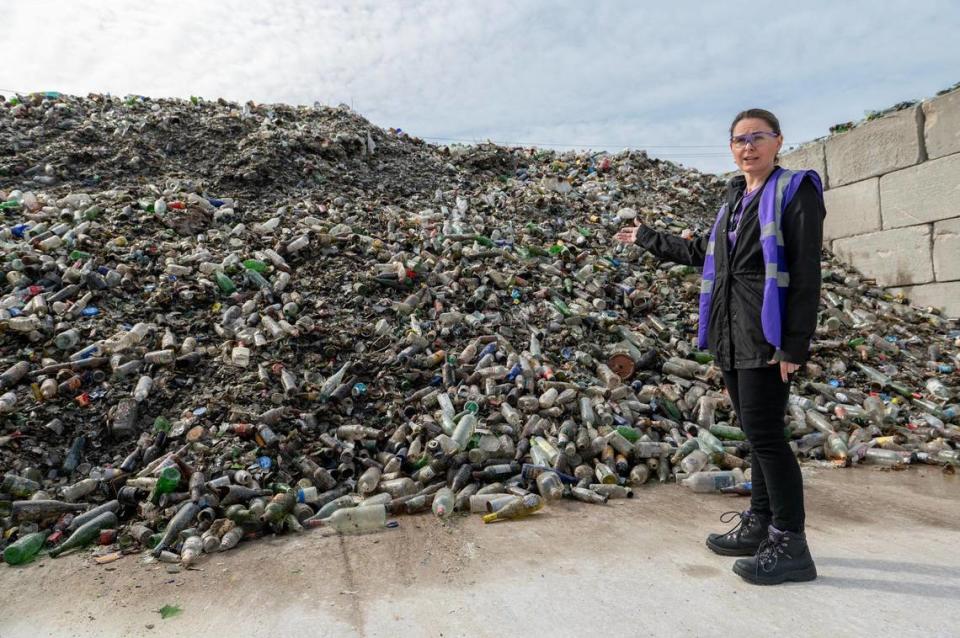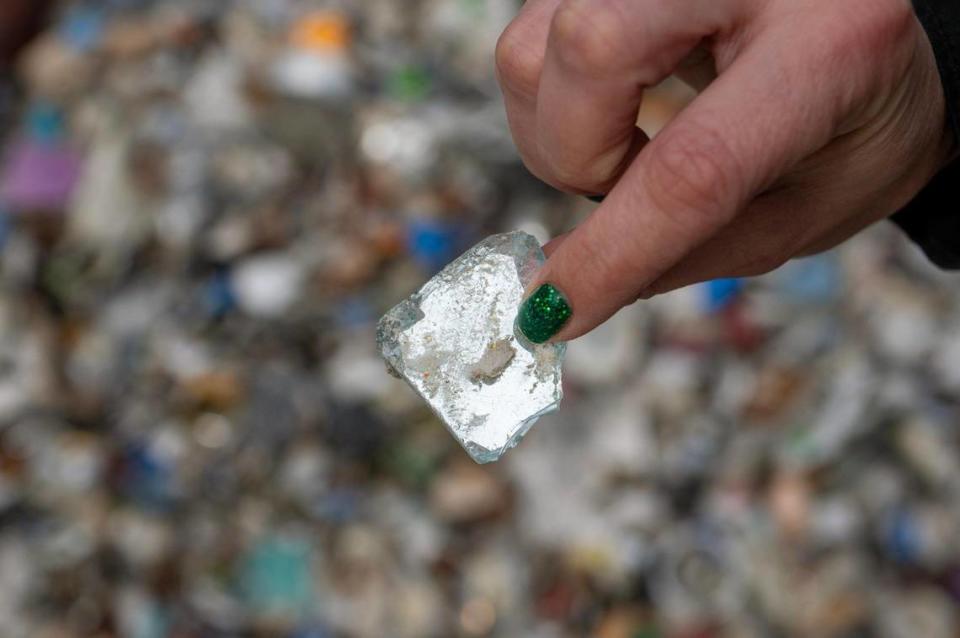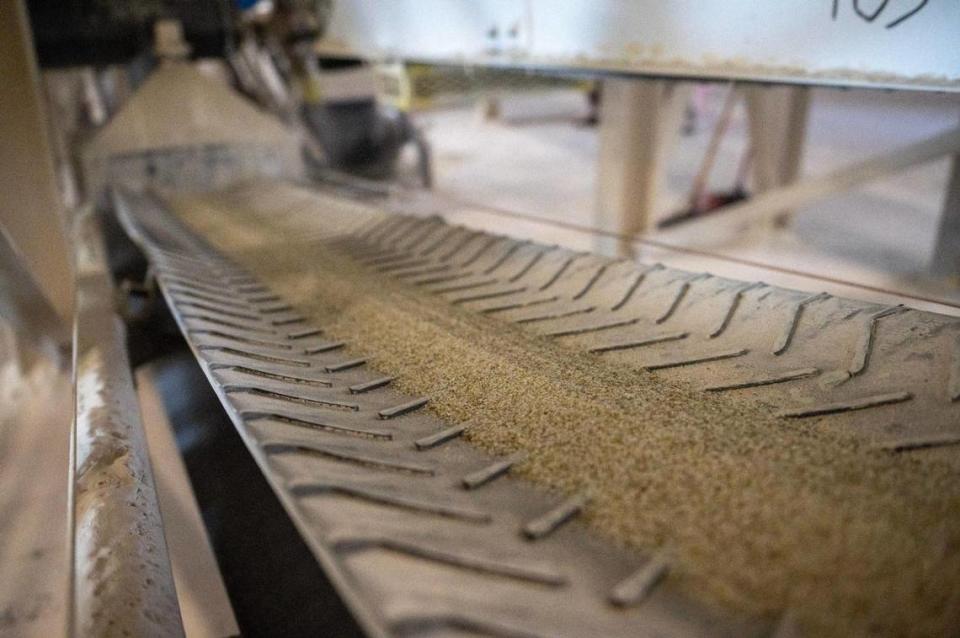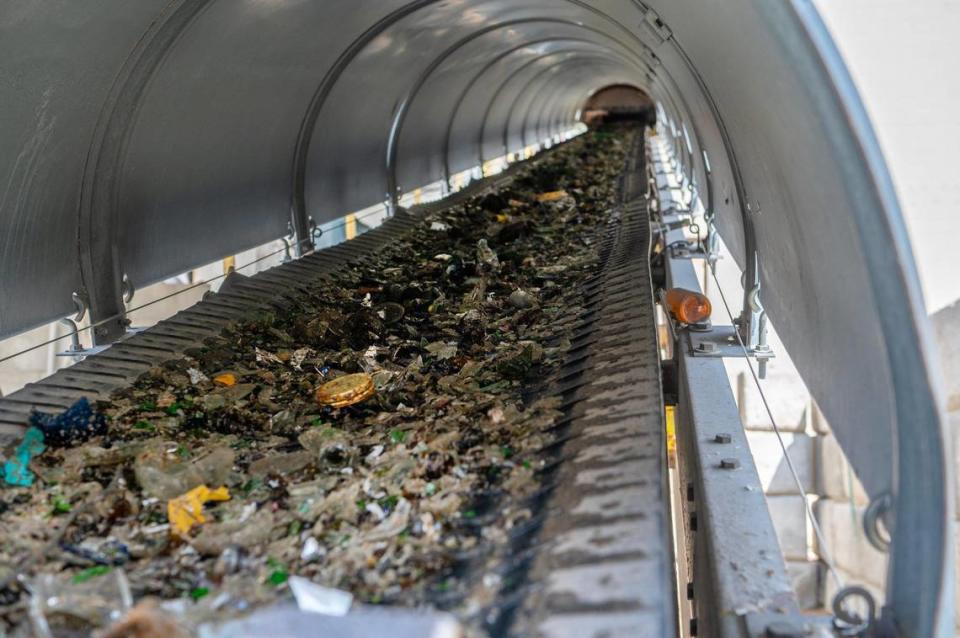Glass recycling is its own process in Kansas City. Here’s how it works & why it matters
Editor’s note: This story is part of The Star’s series “Talking Trash.” All of the stories were inspired by questions and concerns we heard from Kansas Citians through listening sessions, an online callout and other conversations in our community. Stories will run throughout April, and you can find them all here. You can share thoughts in the form at the bottom of this story, or email kcq@kcstar.com.
Not many dumpsters are purple.
That’s part of why Ripple Glass, Kansas City’s most robust glass recycling operation, chose the color: to stand out among the gray, green and blue seen all around the city.
“We wanted something that was distinct, something different. And we also wanted it to be fun,” said Lydia Gibson, the organization’s director of sustainability and strategic analysis. “Glass represents good times — it packages some of the most fun food and beverages out there. We want glass recycling to be representative of that kind of package.”
But Kansas City’s bottles, jars, vases and other glass items have only just begun their journey when eco-minded residents deposit them into the organization’s roughly 110 purple dumpsters around the metro.
They are trucked to the Ripple Glass processing facility on the far east side of the city where they’re cleaned, sorted and processed into a coarse, sand-like material called “cullet.” This raw material is then sold to a fiberglass manufacturer in Kansas City, Kansas.
Gibson estimates that Ripple Glass processes over 100 tons of recycled glass every single day — and that their equipment could easily handle double the load they receive now.
“There’s a lot of glass not getting recycled, but there’s no shortage of demand for recycled glass from manufacturers,” she said. “Melting recycled glass takes (around) 40% less energy than making raw glass from raw materials… it’s more efficient, and it’s more environmentally friendly.”

How does Kansas City’s glass get recycled?
When a purple dumpster starts getting full, it’s rolled onto the back of a large truck and driven to the Ripple Glass plant. There, it’s dumped out with a cacophonous shattering noise into huge outdoor bays.
An enormous front-end loader then scoops the dumpster’s contents out of these towering piles and into a metal chute that sends it up a conveyor belt and into the processing plant. On its way in, the raw material passes under a magnet that lifts out metal pieces like bottle caps, cans and jar lids.
Ripple Glass accepts almost all glass items in any condition — that includes bottles and jars that still bear their labels, lids, residual food and other non-glass components. The main objective of the processing system is to separate these contaminants from the glass itself.
This happens from beginning to end inside a large warehouse, where thundering equipment dries, grinds, sorts and shakes the material high over workers’ heads. The air is filled with a fine white powder — the smallest particles released by crushing bottles and jars into manageable pieces.
The jewel of the operation is an optical sorting machine, which uses high-speed cameras to distinguish pieces of glass from bits of metal, plastic, paper and the most common contaminant of the operation: ceramic fragments.
“Ceramic, stone and porcelain, that is our number one contaminant,” said Gibson. “It kind of has that same feel of glass, but it melts at a much higher temperature than glass does. So what happens when that makes its way into the furnaces of glass manufacturers, is it doesn’t melt alongside the rest of the glass.”
For this reason, Ripple Glass asks that residents avoid throwing plates, mugs, ceramic vases and other common dishware into their purple bins. Too much ceramics contamination can lower the quality of the sandy end product that rides a conveyor belt back out of the warehouse and into the bed of a semi truck headed for Owens Corning, a Kansas City, Kansas company that manufactures fiberglass insulation.
The metal scraps collected at the beginning of the process get sent to another recycling center. That leaves only plastic caps, wisps of paper labels and non-glass items from the purple bins destined for the landfill.

Why does Kansas City recycle its glass this way?
It wasn’t always like this. Deffenbaugh Industries, which used to provide recycling in the metro, accepted glass up until the early 2000s. Then the company stopped accepting it, leaving residents with few options besides sending it to the landfill.
“Glass is a very problematic material to be collected commingled with other materials, because it breaks,” said Matt Riggs, an outreach coordinator with the Mid-America Regional Council’s Solid Waste Division.
He explained that small shards of glass can easily get mixed with paper and cardboard and ruin its ability to be recycled. Glass is also a low-value recyclable material because it’s cheap to produce. But Riggs added that Ripple Glass has created and sustained a market for glass in the area over the past 15 years.
“Owens Corning is really the ultimate end market,” he said. “That’s one of the success stories in our metro area because it’s a completely closed recycle loop.”
And this success is soon to spread beyond just the Kansas City metro. Ripple Glass was recently acquired by Strategic Materials Inc., one of the nation’s largest glass recyclers. With their help, the organization is currently rolling out a similar program in a brand new city: Atlanta.
“They’ve got very limited glass recycling, so they’re kind of back where we were before Ripple got started,” Gibson said. “Getting to make an even bigger impact, that’s the real excitement behind this opportunity.”

How can I recycle my glass more responsibly?
When you see a purple Ripple Glass bin, the first step is not to mistake it for a regular dumpster. Employees have found food waste, appliances and even a whole couch in their dumpsters. But as long as you’re throwing glass in, the rules are pretty relaxed: food and cosmetics residue, caps, lids, labels and bottle rings are all allowed.
There are only three types of glass items that Gibson and plant manager Justin Miller told The Star they don’t accept: lightbulbs, windshields, and Pyrex brand cookware like brownie pans and measuring cups.
Miller added that one broken Pyrex dish won’t ruin a whole dumpster’s worth of recycled glass. However, the type of glass these products use can cause problems in larger quantities because it has a higher melting point than regular glass products, posing issues for manufacturers.

Other than these three items, Ripple Glass will take anything made from glass: vases, artwork, shards from broken windows, marbles, chandelier crystals and even glass smoking accessories. The organization ultimately hopes to keep nearly all of Kansas City’s unwanted glass out of the landfill.
“We want to maximize what we’ve built and be able to continue to create more jobs in glass recycling,” Gibson said. “Right now we don’t run overnight. But if we got more glass, there could be another shift. We cannot get enough glass.”
You can find a purple Ripple Glass dumpster near you on this map.
Do you have more questions about recycling in Kansas City? Ask the Service Journalism team at kcq@kcstar.com.


